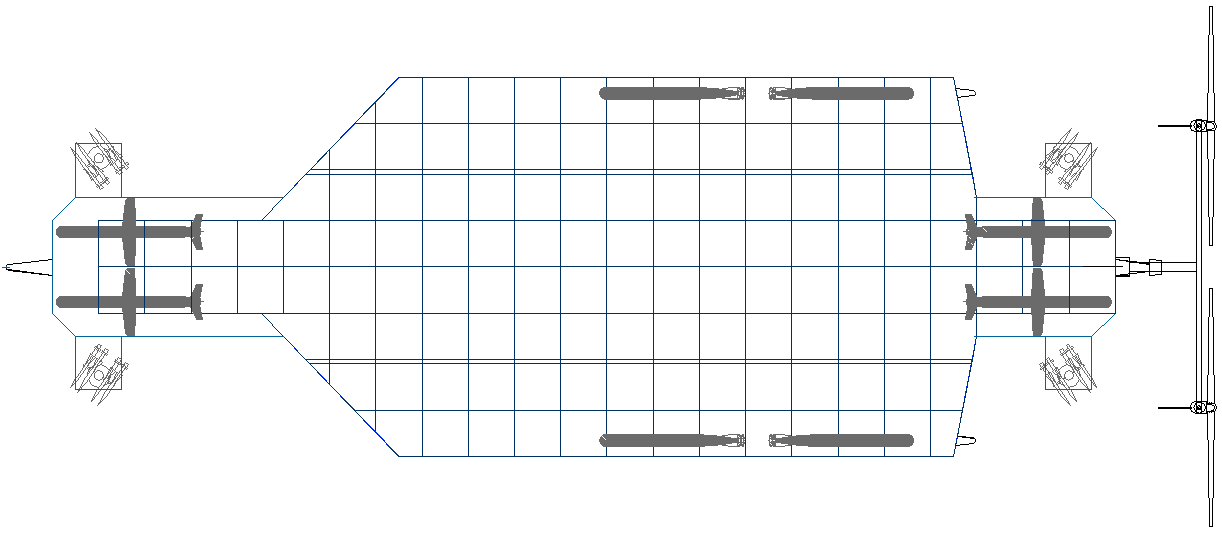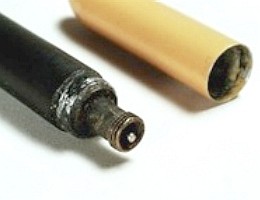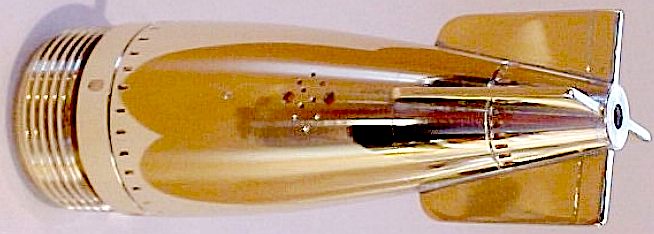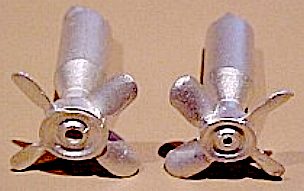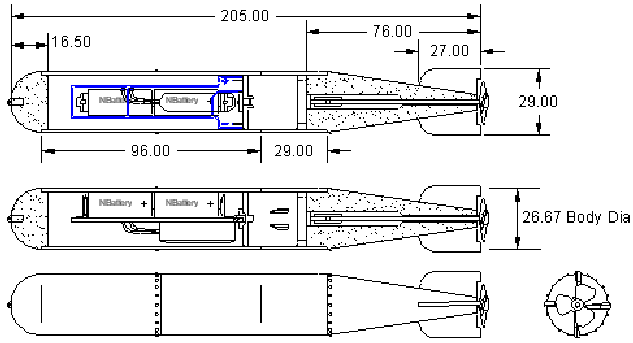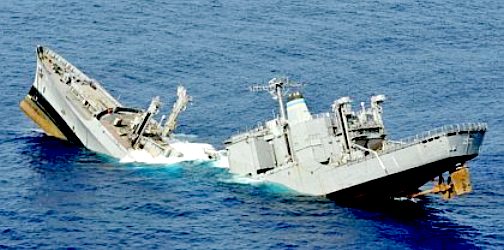|
SCORPION HK - MODEL R/C 1/20th TORPEDOES
|
||||||||||||||||||||||||||||||||||||||||||||||||||||||||||||||||||||||||
|
A MK48 heavyweight 21" torpedo costs around $3,800,000 (£2,396,917) and is nowhere near so much fun to fire and steer onto a target at a community pond, as a model torpedo costing about £250. Also, nobody gets hurt @ 1/20th scale. Imagine naval war-gaming setting a Scorpion HK against a battleship. What a shame that at this scale, SAMS may not be guided. There is though hope the bigger cruise missiles. How about a prize for hitting an enemy target. You'd then have a bunch of students developing guidance systems to be able to compete with one another.
THE 1/20th SCALE NAVAL MODEL - TORPEDOES
Firstly, and please note that BMS have no aspirations to be and MOD supplier or subcontractor. This exercise is simply some harmless wargaming fun. Please bear that in mind when reading how we went about producing a warship of the future. We'll let the Navy catch up in about 30 years.
A military version (Scorpion HK) of the Bluefish zero carbon cruiser (ZCC) is to have the equivalent of up to four MK 48 type torpedoes installed. Two of these torpedoes will fire facing forward and two will fire backwards on the 1/20th scale model to prove the concept. These steel fish are to be carried in the active hull in tubes so that buoyancy adjustment for loss of mass on firing is automatically compensated by the vessel's true running system. Using the existing feature of our ZCC design saves complications. At this time, no other vessel has such a feature.
Scorpion's torpedoes will be launched using compressed gas, then the outer doors closed to enable whatever water has got in, to be pumped out. The run distance of each model torpedo will be around 1 mile @ 5 knots, using lithium cells, and they can be guided onto a target - provided you have a wicked set of binoculars. That sits well with John Drain's findings. His torps run for about 15 mins at (we guess) 2.25mph = .56 mile range. You can increase the range and speed, by simply adding more cells and using higher gearing (or steeper pitch props). We'd also suggest using some efficient brushless motors, to really blaze a trail.
A Scorpion HK - fitted with 4 x SAM turrets (one per corner), for 360 degree independent cover. Each SAM turret carries 8 missiles (Rapier example), giving a battery of 32 rockets to fend off enemy aircraft. The micro battleship is also shown here with 4 Tomahawk cruise missiles in protected bays, fore and aft, and 4 x 21" MK48 torpedoes in the outriggers - all drawn to scale - as a prelude to proof of concept. The torpedoes and cruise missiles would not be visible, but we've shown them as though the drawing were an x-ray. The OAL of this genius design is 52.7m or 171 feet. She can cruise all day and night at 7-10 knots and sprint up to 25knots, depending on specification.
This original concept vessel is design copyright © BMS Ltd 2014. The technology is also patent applied for. Being an unmanned drone, there is no need for crew quarters, provisions or other life support. What is essential is a robust onboard navigation system that is artificially intelligent. Another essential, is encrypted satellite communications, such that firing of missiles is sanctioned by a human operator. If fired upon, the robot ship will return fire in self-defence mode. RoboShip is about to come of age.
The battleship also carries a ROV that may be deployed from the mothership remotely, with other sensors to locate and clear mines. In tandem with military surveillance duties, the ship can sample and map the oceans all at the same time. That could save any navy a pretty penny - not to mention - that this vehicle is powered by energy from nature. So, no nuclear waste and no diesel smog.
The length of a MK 48 is 19 ft (5790 mm) and the diameter is 21 inches (533 mm). The 1/20th model torpedo will thus be 290mm (11 7/16th") x 27mm (1 1/16th"), or as near as we can manage to that using cheaply available off the shelf parts. That is a pity, because there are some talented model makers out there and we were hoping to be able to simply purchase ready made torps, where all the graft may have already been done. (Some fine examples of other modeler's methods are given below)
The same Scorpion HK model will carry 1/20th scale SAM and cruise missiles. The cruise missile will be mounted under the solar decks and launched horizontally using rockets, much as they launch Tomahawks from the decks of ships at the moment. The SAM missiles will be mounted on twin fore and aft turrets to enable rapid, truly independent, multiple target acquisition. You can read more on these other features using the links below:
1. SAM MISSILES 3. TORPEDOES
WHAT'S SO SPECIAL ABOUT THE SCORPION & DRAGONFLY HKs?
Apart from the fact that once launched there are no fuel costs for these naval drones, the unique hull design provides a degree of flexibility that is unparallel in naval military history for such a compact craft.
To now, it has not been possible to use one basic design platform to undertake so many different military functions. On this page we take a look at the method of housing and firing standard 21" and 12.75" torpedoes. The 1/20th scale is just big enough to be able to use components and materials that are commonly available in most well stocked hobby and hardware stores.
J. COSTING ESTIMATES FOR R/C MODEL TORPEDOES x 4 @ 1/20TH SCALE
OTHER MODEL MAKERS METHODS
When deciding on making model torpedoes, it pays to look at how other model makers have tackled the subject. There are several different methods that seem to work well, each with advantages and disadvantages. Two of these are investigated below. Remember though that our objective is just to show that a Scorpion HK is capable of housing torpedoes and other armaments - by way of a very basic feasibility study.
This is Mike Dory's rather neat solution to recharge a compressed gas powered torpedo. The range is not that great, but the torp steers straight.
MIKE DORY'S COMPRESSED GAS TORPEDO - Does it shoot torpedoes?
One of the biggest crowd-pleasers for a model submarine is working torpedoes. These torpedoes are relatively inexpensive to build, very durable, easy to maintain and ALWAYS please the crowd! This is how Mike Dory builds torpedoes for his RC model submarines.
This isn't the only way and may not be best way to do it, but it's what works
for Mike. He stresses by way of disclaimer, that if you decide to make this
design of torpedoes, you are on your own! BMS say that that goes for any
torpedo on this page or in the internet ether.
3. Cylindrical aluminum block as a base for the tire valve 4. Schrader tire valve to fill propellant into torpedo body 5. Hot Stuff brand CA adhesive 6. an old .035 drill bit for the firing pin 7. Nyrod with threaded brass end-piece to pull the pin 8. Nylon rod for nozzle 9.
Sheet styrene plastic for fins
The nosepiece is a bullet-shaped piece of hardwood dowel rod glued into a 2.25 section of 5/8 aluminum tubing. The next 4.75 is aluminum tubing and the aluminum tail section is 1.25 with .25 of that fitted into the end of the tube. A Schrader tire valve (available at any auto parts store) is mounted in a hole in a cylindrical aluminum block that is glued and press-fitted into the aluminum torpedo body using a CA adhesive product called Hot Stuff. I remove the rubber part of the valve that goes into the tire rim with a lathe.
A bit of the threaded end of the valve is trimmed off to increase the torpedo's buoyancy. The valve is for filling the
torpedo with compressed liquid propellant like Propel or Super Duster.
Mike switched to Super Duster in his sub's ballast systems a number of years ago since it
seemed to be less corrosive to the ballast valves.
This is the engineering magic that reverses the direction of rotation of one shaft that is located within another. The essential element of this design is the crosshead and bevel pinions.
The above drawing shows how complex is the workings of a torpedo. This one is compressed air powered, the gas escaping through the hollow propeller shafts. They stopped using compressed air during WWII because it was too easy for men on watch to spot the bubbles on the surface. The move to electric motors cured that.
The Mark 14 torpedo was the
US Navy's standard submarine launched anti-ship torpedo of World War II. This weapon was plagued with
problems which crippled its performance early in the war, and was supplemented by the Mark 18 electric torpedo in the last two years of the war. Nonetheless, the Mark 14 played a major role in the devastating blow US Navy submarines dealt to the Japanese naval and merchant marine
fleets during the Pacific War.
By the end of World War II, the Mark 14 torpedo was a reliable weapon which remained in service for almost 40 years
and even longer with other navies.
JOHN DRAIN'S SUPERB MKXIII 1/20th SCALE MODEL TORPEDO DEVELOPMENT
John's objective was/is to produce an operational 1/20th scale WW2 US Navy MkXIII torpedo, complete with dual counter-rotational propellers. John had completed a relatively easy to make single prop model that performed well except that the body of the "fish" rotated in the opposite direction to the propeller caused by the bearing friction (a problem common to helicopters, and that just was not good enough, where such a design will give you a torpedo that wanders off course - hence, misses its target. His first torpedo was made of balsa wood, that is cheap, so he could afford to lose a couple in testing. John's balsa model torpedoes in 1/20th scale are 26mm dia and 206mm long. The resin cast project is 28.5mm diameter and 204.5mm long.
BALSA BEAUTIES
- SINGLE MABUCHI MOTOR/PROP
John's lovely brass master tail fin
RESIN BABES - DUAL MABUCHI MOTORS & CONTRA-ROTATING PROPS
In real life, torps are fairly complex and that means costly. Regardless of the technical challenge, John decided to make a 1/20th model with contra-rotating propellers. Wow! Not only that, but he developed two different systems, one with a single electric motor and a bevel geared arrangement to drive two shafts, one inside the other. And then a two motor system, where one motor is ahead of the other, driving a shaft that passes through the rear motor. This meant replacing the solid drive shaft of the rear motor, with a hollow shaft - as both motors were in-line. Brilliant. John describes knocking out the steel motor spindle (2mm) and replacing that with hollow brass tube (2mm OD 1.5+mm ID), as being "tricky but not difficult!"
Not only that, but John designed a printed circuit board for the project. Possibly a bit over the top, but then casting your own propellers in silver is also going that extra mile.
ABOVE: The superb PCB sporting dual Mabuchi motors - BELOW: complete torpedo resin casing assembled and ready to paint. The same 'through-motor' system could be used by aircraft modelers to recreate contra-rotating propellers on WWII aircraft. Why is no motor manufacturer making such a setup now that the space-saving innovation has been revealed?
To house all this wizardry John elected to make resin cast casings. He began by making a master tail for his moulds out of brass - and a fine piece of work that is. From this threaded master, and after several failed attempts at making a mould himself (it is tricky), a local jeweler made up a rubber (probably silicone) mould. This was used in conjunction with a brass inner, or plug, such that the resin casting came out hollow. Obviously, this process is fiddly, but imagine using a shaped charge to form a rocket cone, as NASA do sometimes. Or, making a swaged tube, which requires a tungsten two-piece dies (the metal equivalent of a mold) and plenty of lard for lubrication - as a spinning tube is pushed into the dies. By this means metal pen caps are made from brass or gold tubing, and soft drink cans are deep drawn from aluminium sheets. You need to make a very accurate nose cone, or dome, or any skew will act to steer the torpedo in different directions as the body rotates, especially with a single prop - making things very unpredictable. A bit like firing a fuse cannon in a swell. Who knows on which roll of the ship it will fire.
ELECTRIC MOTORS
A far simpler modeling solution - still with the crosshead and bevel pinions
The assembly will fit in the new resin body to hold the cross beam with the pinion gears. The crown gears are modified by cutting off the "hat" section with a sharp scalpel and the holes need to be drilled out slightly to fit.
John's splendid silver props. Contra-rotation not only balances out bearing friction spin, but also increase the conversion efficiency of the propellers, in creating thrust from what is in effect a rotary wing.
SILVER PROPELLERS
The silver hubs are tapered to match the shape of the torpedo body, so the front prop has a larger hub than the rear and different size holes: 2mm for the first (closest to the torp body) and 1mm for the shaft within the shaft (the end prop). The blades were made the same size for both props to move the same amount of water for a balanced thrust - to help prevent torpedo body rotation. This means that the rear (end) propeller is smaller in overall diameter by the difference in hub size.
John's drawing of the US Navy torpedo, scaled as the 1/20th model
TWIN
MOTOR CIRCUIT BOARD
* Three "Ultra Low On Resistance" MosFet transistors per motor * A reed switch * Two surface mount resistors (smr) * Three surface mount capacitors (smc) * Seven surface mount transistors (smt), and * Four battery clips.
Lastly, in go the two modified motors, one of which has a hollow shaft. Hence, the torpedo is a: "hollow shaft torpedo." John prefers "hollow motor torpedo." Whatever name you give it, it's hats off to John for thinking of it. Didn't Ken Norris do something like this with Donald Campbell's jet engined Bluebird CN7, where drive shafts came out of the back and front of the engine, to give four wheel drive? Not quite, but the logical thought (drive) train is similar.
Simple but effective. The above magnetic reed switch keeps the motor power circuit open, until launched into the water, where there us no magnet - so the circuit completes and off she goes.
MAGNETIC REED SWITCH
The magnet must be mounted the right way around or it won't work. These switches are magnet biased to stay ON when away from the main magnet. Be careful here, you need a reed that is OPEN when near the magnet - rather than closed. The heavy mountings can be cut off to reduce the overall weight.
You try and buy a true 8 channel digital proportional RC set for under £100. Not only that, but this combination rig allows some neat tricks without getting all hot under the collar. It's ideal for aiming SAMS, firing cruise missiles and guiding torpedoes - all in one command unit.
TORPEDO GUIDANCE SYSTEM
Neither of Mike or John's masterpieces are steer-able, but it is a relatively simple matter to include a rudder and magnetic coil system, to be able to guide the torpedo to her target using a standard R/C set. We will be doing this with our version of the MK48s. We've worked out how to obtain running stability for the steering to work, with just one fin-rudder. As time allows we will post for other submarine modelers to enjoy.
We'll
leave it to John to give the weapon bite with an explosive head. Wargaming
clubs used blanks as the charge, routinely leaving 2" holes in
the side of ships targeted - at which point they were written out of the
rules. Why? We'd not be
content with a crack from a firing pin. Most torpedoes though, use
proximity fuses - so even easier. The problem then is disposability and
cost per shot. That is of course the cost of real warfare, where torpedoes
cost an arm and a leg.
THE SUB COMMITTEE
The SubCommittee is a not-for-profit organization of members from around the globe who share an interest in building model submarines. As a group they are dedicated to the advancement of the submarine modeling hobby.
The SubCommittee was created in 1990 as a network of like minded submarine enthusiasts to pool their resources.
The founding members were Ken Hart, Marshall Clark.
The SubCommittee brought together outstanding modelers from around the world and pooled their resources in the SubCommittee Report, or SCR, the world's first magazine dedicated to submarine modelling.
SUBREGATTA
With membership growth SC held their first international meeting called: SubRegatta. SubRegatta was so successful that it became an annual event, initially hosted by the U.S. Submarine Base in Groton, CT. The event moved to Johnston, RI following the commencement of the War on Terror in 2001. SubRegatta subsequently moved to Carmel, IN in 2005 and has been held there to this day.
A ship that a Navy used for target practice attracts a direct hit that breaks its back from a torpedo hit. Such damage causes any vessel to sink almost immediately in two parts. Wartime footage of ships that are struck by torpedoes shows just how quickly a large ship can go under.
SUBMARINE INDEX
Alvin DSV - Woods Hole Oceanographic Institution Deepsea Challenger - Mariana Trench, James Cameron 2012 HMS Astute 1st of Class HMS Vanguard- Trident INS Sindhurakshak - explosion & sinking Littoral combat vessels Lusitania - Torpedo attack Nuclear submarines lost at sea Predator - Covert submarine hunter/killer Seawolf - Autonomous wolf pack deployment of Predator mini-subs Torpedoes - UUV anti submarine weapons Trieste - World record depth - Mariana Trench 1960 U20 - Kapitan Leutnant Walther Schwieger USS Bluefish WWI submarine USS Bluefish - Nuclear submarine USS Jimmy Carter - Seawolf class fast attack nuclear submarine USS Nautilus - 1st nuclear submarine & subsea north pole passage USS North Dakota - 11th Virginia class submarine USS Scorpion - Lost at sea with all hands
LINKS & REFERENCE
http://www.rc-submarines.net/torpedoes.html PT boat contra rotating electric torpedo Radio Controlled submarines how do you keep the water out http://en.wikipedia.org/wiki/Mark_14_torpedo https://www.schraderinternational.com/ http://www.rc-submarines.net/how-do-you-keep-the-water-out.html http://www.subcommittee.com/ http://www.rc-submarines.net/torpedoes.html http://www.pt-boat.com/torpedo/torpedo.html
BLUEFISH DEVELOPMENT PROJECT INDEX A-Z
OPERATION NEPTUNE - A naval battle royal with NATO chasing a stolen nuclear submarine captained by environmental terrorists, who destroy another oil rig in the Gulf of Mexico, after Deepwater Horizon, then sink an aircraft carrier and one of the submarines chasing them. Amidst the carnage, Charley Temple and John Storm move their budding relationship up another gear and still manage to save the day. If you enjoyed Battleship, Under Siege, or Pacific Rim, you'll love this story.
|
||||||||||||||||||||||||||||||||||||||||||||||||||||||||||||||||||||||||
|
This website is Copyright © 2014 Bluebird Marine Systems Ltd. The names Bluebird, Bluefish, SeaNet, SeaWolf and the blue bird and fish in flight logos are trademarks. CONTACTS The color blue is a protected feature of the trademarks.
|
||||||||||||||||||||||||||||||||||||||||||||||||||||||||||||||||||||||||
